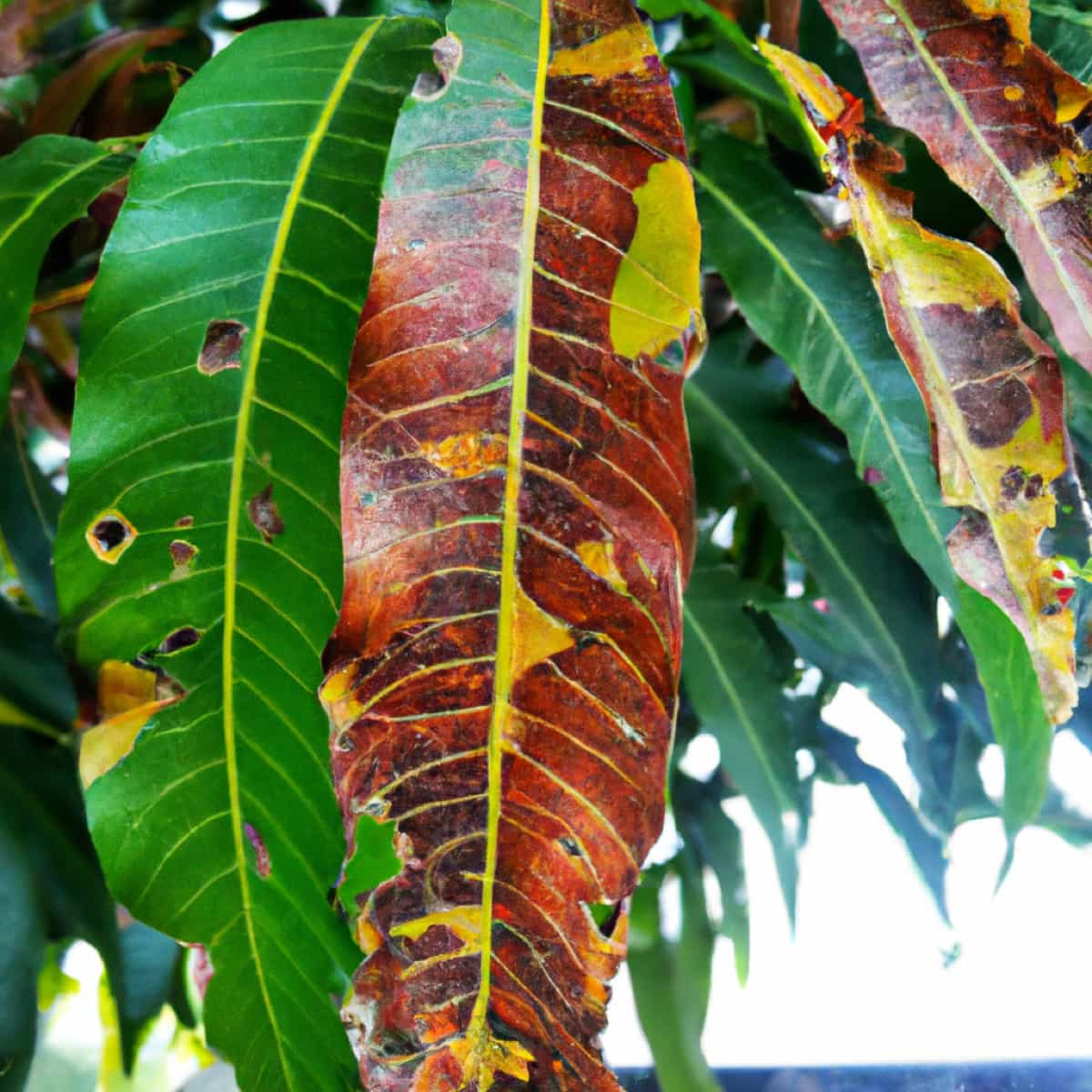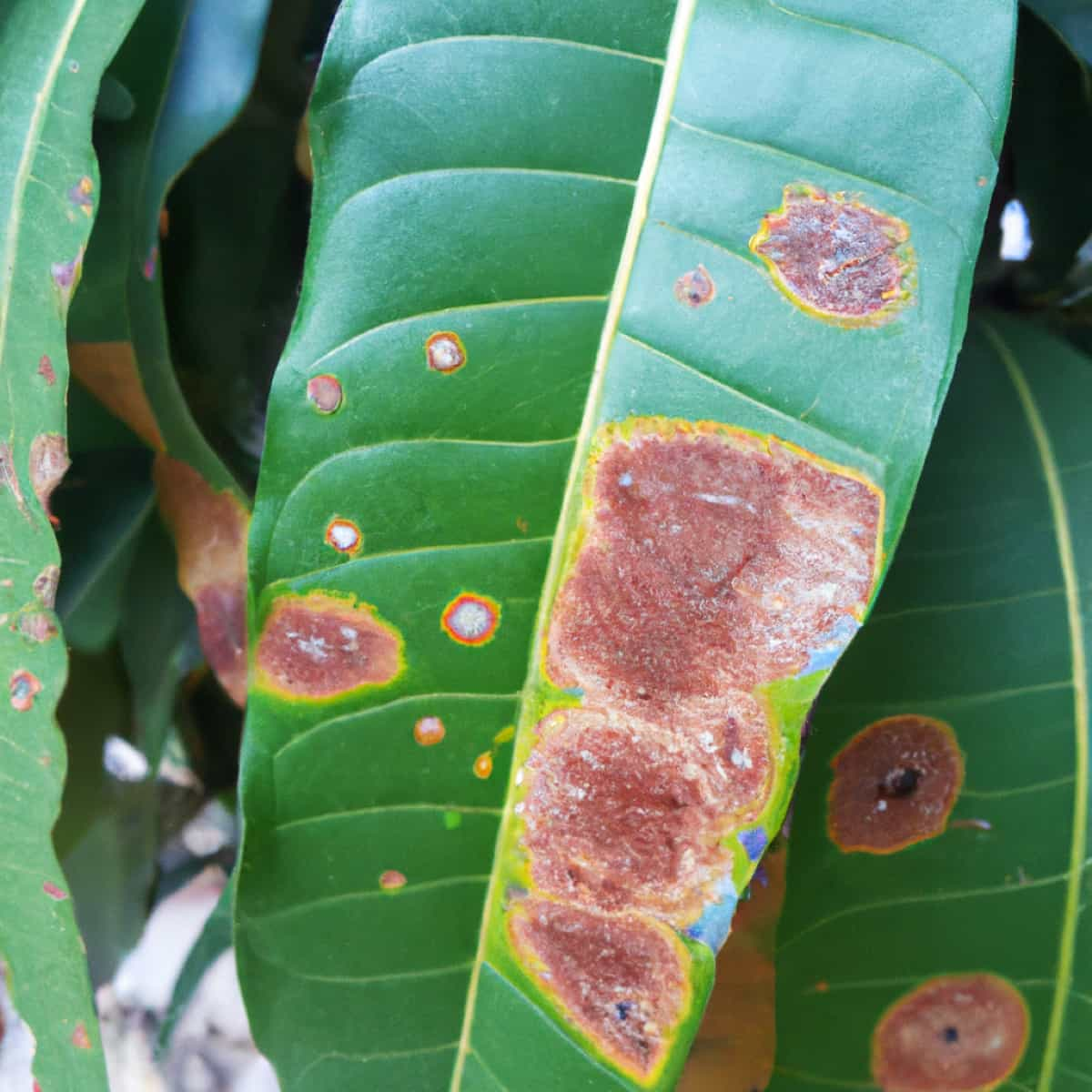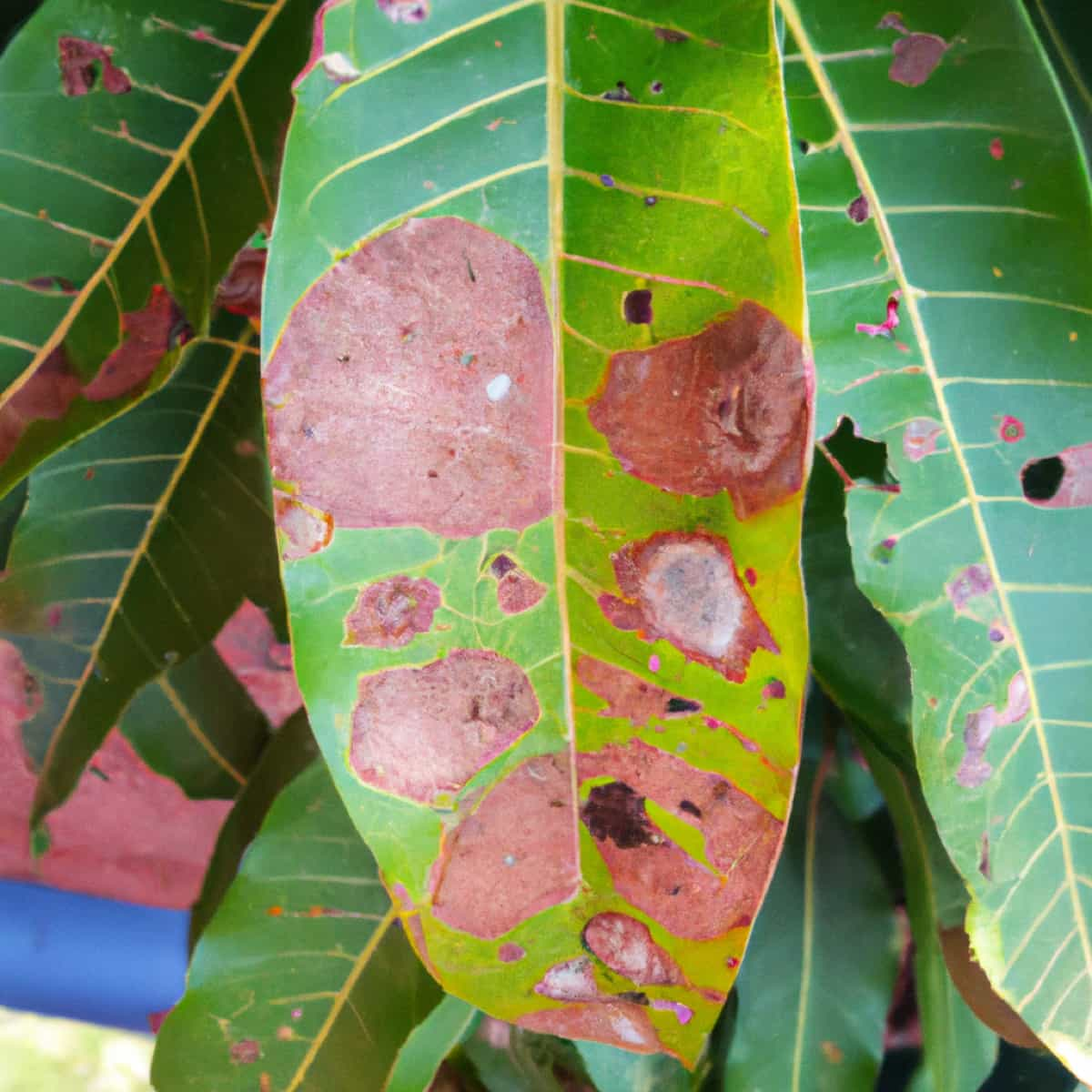The Mango Red Rust Disease is an epiphytic algal disease caused by the algae Cephaleuros virescens. It is a foliar disease most often found in humid climates and is particularly prevalent in tropical areas. The algae are spread by wind-blown spores, and the disease can spread quickly among trees in the same area. Management of this disease is important to prevent yield losses and includes cultural practices such as pruning, irrigation, and crop rotation.

Algaecides may also be used to control the disease, but they should be used cautiously and in combination with other management practices. To effectively manage this disease, it is important to understand its disease cycle, the mode of disease spread, and the best methods for controlling it. This article will provide an overview and discussion of the Mango Red Rust Disease in Mango crops, including its symptoms, identification techniques, and control.
Mango Red Rust Disease Management
The Causal Organism of Mango Red Rust Disease
- Cephaleuros virescens is a hemibiotrophic, saprophytic pathogen that belongs to the Family Trentepohliaceae of Order Trentepohliales of the Phylum Chlorophyta.
- The pathogen is found in the mango tree’s vegetative and reproductive stages.
- The sporangia produced on the thallus are thick-walled and sessile with orange-colored pigments.
- After ripening, the sporangia produce zoospores and disseminate them through a pore in the wall. The zoospores actively swim with the help of cilia, and they are ovoid and orange in color.
The Disease Cycle of Mango Red Rust Disease
The disease cycle of the Mango Red Rust Disease, Cephaleuros virescens, in Mango Crops begins when the algal spores are dispersed by wind and rain and settle on the leaves of the mango tree. Once the spores settle, they germinate and form a new alga, producing red-brown rust on the leaf surface. This rust comprises small, round, reddish-brown spots, which may eventually cover the entire leaf. As the disease progresses, the rust spots will become more numerous and darker, and the leaves may become brittle, yellow, and fall off.
In severe cases, the branches may die, and the tree may be killed. The algal spores may remain on the dead leaf surface, and once they come in contact with other mango trees, they can cause an outbreak. The algal spores can also be spread from one tree to another through infected pruning tools or infected soil particles carried by wind or water. Additionally, the spores may be spread through contaminated irrigation water. Once the spores are spread, the disease cycle can begin again.
Occurrence of Mango Red Rust Disease in Mango Crop
- Location of Mango Red Rust disease: This disease occurs in mango crops in India, Africa, Bangladesh, Sri Lanka, Vietnam, Thailand, Malaysia, Indonesia, the Philippines, the United States, Mexico, Brazil, and Australia.
- Host range: The most common crops affected by Cephaleuros virescens are mango, watermelons, cantaloupes, squash, cucumbers, tomatoes, and peppers.
Favorable Conditions for Mango Red Rust Disease Spread in the Field
- Warm and humid conditions, high relative humidity, and temperatures between 24–32°C are ideal for spreading the disease through wind-borne spores.
- As the pathogen needs a moist environment to survive, the wetness of leaves contributes to the spread of the disease.
- The presence of dust particles or other suspended particles on the leaves can also promote the spread of the disease.
- The disease can also be spread through water splash from irrigation and rain, as well as through infected pruning tools or from infected plants.
- The pathogen can also survive on dead leaves and spread to healthy plants through the wind or insects.
In case you missed it: Mango Powdery Mildew Disease Management: Symptoms, Treatment, Chemical, Biological, Natural, and Organic Control

Damage Symptoms of Mango Red Rust Disease
- The disease is characterized by reddish-brown spots on the leaves and stems of mango trees.
- The algae primarily parasitize leaves and young branches of the plant.
- It typically starts as a small, circular, marginally elevated, yellow-orange spot on the leaves, then progresses to a red-rust color over time.
- The spores produced from the spots will fall off, leaving creamy white velvety texture spots on the leaf surfaces. These spots will turn reddish-brown over time.
- The affected leaves will turn yellow and eventually drop off due to the algal infection, and the stems will crack. The algae can also spread to the petioles, bark, and fruit, causing small, reddish-brown spots.
- The infested plants show defoliation of plant leaves that causes reduced photosynthetic activity.
Percentage of Yield Loss due to Mango Red Rust Disease in Mango Crop
- The disease can cause 10% yield losses in the United States. In Mexico, yield losses are between 40-70%. In India, the yield losses are 50%. In Bangladesh, Nepal, and Sri Lanka, the losses are 40%. In China, a 50-80% yield loss is seen. In Thailand, it is between 60-80%.
- In Africa, yield losses are at 20%. In the Philippines, it is 50-80%. In Brazil, it is up to 20%. The Economic Threshold Level is determined at 5% of the crop leaves.
Cultural Control measures of Mango Red Rust Disease
- Providing shade and wind protection to the tree can help reduce the spread of the disease.
- Keeping the tree in a well-drained area and avoiding overwatering or overfertilizing helps to keep the tree healthy, which prevents the disease from taking hold.
- Prune the trees regularly to remove infected branches and keep the tree free of dead or decaying material that can harbor the disease.
- Good sanitation practices should be followed in the orchard; the debris should be removed, tools should be disinfected between uses, and weeding should be done regularly.
- Perform Roguing out operations in the orchards to remove and destroy the diseased plants.
Biological Control measures of Mango Red Rust Disease
- The fungus Trichoderma harzianum can destroy the algal organism by producing toxins that break down the cell walls and destroy the algal cell structure of the organism, thus killing it.
- The fungus Beauveria bassiana can infect and kill the algal spores.
- The bacteria Bacillus subtilis, Pseudomonas fluorescens, and Streptomyces spp. produce enzymes that break down the algal cell walls, leading to the death of the algal organism.
- Predatory mites, Stratiolaelaps scimitus, feed on the algal spores, reducing the number of spores in the environment and thus reducing the severity of the disease.
Chemical Control measures of Mango Red Rust Disease
- Curative Algaecides – These chemicals are used after the disease occurs. Spray the algaecides, Bordeaux mixture, Mancozeb, Strobilurins, Chlorothalonil, and Copper Oxychloride.
- Protective Algaecides – These chemicals will form a protective barrier on the mango leaves and stems, preventing the algal spores from colonizing the plant. Spray Dithiocarbamates, Captan, and Thiophanate-methyl.
Organic Control measures of Mango Red Rust Disease
- Citric acid, Vinegar, and Hydrogen Peroxide (H2O2) are the most commonly used natural algaecides to control mango red rust disease.
- Citric acid obtained from citrus fruits, such as lemons and limes, acts as a natural algicide by disrupting the cell membranes of algae, preventing them from growing and spreading.
- Vinegar is a mild acid that can be used to kill algae by creating an environment that is inhospitable to the growth of algae.
- H2O2 is a powerful oxidizing agent that can disrupt the algae’s cell membranes, preventing them from reproducing and spreading.
- Collect the diseased leaves from the orchard and burn them far away from the field to control the disease spread.
Preventive Measures for Control of Mango Red Rust Disease
- Proper fertilization and avoiding water logging can help reduce the algal organism’s impact.
- Regularly monitoring fields for signs of disease, such as diseased leaves and rust spots, will help to catch and manage it early before it spreads.
- Planting mango varieties that are resistant to the algae can reduce the spread and severity of the disease.
- Avoid overhead irrigation, as this can cause the spores of the disease to spread.
- Avoid overcrowding by providing proper crop spacing in the orchards and avoiding contact between infected and healthy plants.
In case you missed it: Mango Flower Webber Pest Management: Symptoms, Treatment, Chemical, Biological, Natural, and Organic Control

Conclusion
The Mango Red Rust Algal Disease, Cephaleuros virescens, is an increasingly common threat to mango crops worldwide. This disease can cause severe crop losses, reduced fruit quality, and reduced yields in mango production. Effective management strategies are necessary to reduce the impact of this disease, such as early detection and prompt removal of infected plants. Additionally, cultural practices and other methods should be employed to reduce the spread of this disease and prevent future outbreaks.
- Beneficial Insects in Pest Management
- Natural Solutions for Pest Control in Flower Gardens
- Types of Fungicides Used in Agriculture
- Common Issues in the Fruit Development Stage of Pomegranate Farming
- Fruit Development Issues in Papaya: Easy Solutions and Treatment
- Soil-Borne Diseases and How to Protect Your Plants
- Practices to Prevent Disease Spread in the Garden
- From Wilted to Thriving: How to Treat Root Rot Naturally in Houseplants
- Natural Remedies to Cure Brown Spots on Fig Tree Leaves